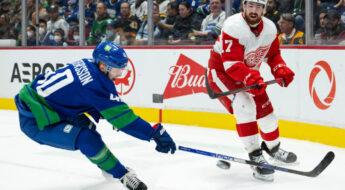3 Jets Under 23: How high can Jacob Trouba climb? (Part 1/2)
This is part one of a two part series. Check out part two here.
Jacob Trouba, Defenceman, 22 years (8th overall in 2012)
When Trouba first broke into the league after dominating college hockey as a freshman, he fit right in from day one. There wasn’t a single game where he seemed out of place, and he showed great power on his skates with bone crushing hits, explosive bursts of speed to evade forechecking opponents, and he put up 29 points and 10 goals in 65 games as a 20 year old rookie. Needless to say, it looked like he had everything, and he projected quickly to dominate all ends of the rink.
However, his point totals have dropped every year, from 29 as a rookie to 22 as a sophomore, and he now has 10 points in 46 games, on pace for a that’s-okay-I-guess 18 points. His shots per game rate has also dropped, dipping from 2.05 per game last year to a measly 1.63 for the current season.
Not the most encouraging of trends for the young defender.
If we take a look at his role, however, it isn’t quite as disappointing as it seems. Trouba has largely played with shutdown defender Mark Stuart over the course of his career – not exactly a teammate ripe with offensive prowess. He’s averaged over 3 minutes of penalty kill time per game, while getting a microscopic 45 seconds of power play time per game, too. The manner in which he’s been deployed hasn’t been conducive to putting up offensive numbers, but more damning than his current statistics or roles is the fact that he has played with Stuart most of his career.
We all know that Stuart likes to chip the puck out. A lot.
I understand the theory of Trouba and Stuart together; they’re both physical and they play the defensive zone of the ice exceptionally. Often times they’re up against their opponents’ best, and they perform well in that role.
But there is no question that Trouba has some untapped offensive potential. We saw it when he first broke into the league – and this often happens with younger players – but once he began to have that defensive responsibility, his offensive instincts were suppressed a little. I’d be very curious to see how he performed with a defenceman capable of matching his offensive prowess, as Stuart just doesn’t have the puck moving or puck possession capability of Trouba or the other Jets defenders.
Interestingly enough, Trouba has been playing with Dustin Byfuglien over the last 16 games and still has only tallied 3 points over that span. Of course, playing with Big Buff means you have more defensive responsibility than ever, but with both players being capable of moving the puck efficiently, you wonder if maybe the offensive side of Trouba has been permanently squashed.
Speaking of Buff, it makes his impending free agency all the more fascinating. I have no idea on whether he’ll stay or go, but should he go there would be a massive role to fill that could be perfect for Trouba’s development. He’s been given a tall task defensively, and he’s responded very well. At some point it will be time to give him true responsibility on both sides of the puck so he can become the franchise defenceman he’s projected since bursting into the league.
Best Case Scenario: Franchise two-way defenceman
Likely Scenario: Top pairing defensive defenceman
Worst Case Scenario: Top pairing defensive defenceman
Verdict: Trouba has plenty of tools to become a consistent 30-40 point player, but until we see more in the offensive zone again, his ceiling figures to be a very capable shutdown defender possessing an excellent first pass who can still play the offensive side of the puck. The likely and worst case scenario are the same because he’s a top pairing defender on most teams around the league, and at 22 years of age, he shouldn’t be getting any worse.
Nic Petan, Center/Wing, 20 years (43rd overall in 2013)
Nic Petan sure was a hell of a junior player. In his final 3 seasons with the Portland Winterhawks, the miniature forward from Delta, British Columbia put up a staggering 322 points in 188 games, good for 1.71 points per game. There’s no denying the skill he possesses.
The way Petan plays is almost as if he has a second set of eyes attached to the puck. He has a remarkable ability to change the angle of the puck ever so slightly in order to find his target with a tape to tape pass. Petan plays with an uncanny presence of mind of where the puck is, and which angles are available to him.
Adding to his vision is strong puck skills. I always say a prime indicator of skill is how well a player can use their backhand, and Petan certainly uses it effectively. Like most players with modest size (5’9″), he has great ability to make tight turns while keeping the puck under control, similar to the way Johnny Gaudreau does it in Calgary. Once he adjusts to the size and strength of the National Hockey League, it will be up to him to decide how well he can use his skillset. He currently has 15 points in 23 games on a pitiful Manitoba Moose squad, so he is able to handle the strength aspect – it’ll be a matter of processing his game just a little bit faster in order to succeed in the NHL.
Best-case scenario: Skilled top line forward
Worst-case scenario: Fourth line forward, power play contributor
Likely scenario: Skilled 3rd line forward, power play contributor
Verdict: I don’t intend any damning prediction when I say Petan’s likely scenario is a 3rd line forward, but players of his size have to show you in the big leagues what they’re capable of first. Petan’s skillset without a doubt has top 6, and maybe even top line forward written all over it, but he’ll have to give us a nice season-long display first. In today’s NHL size matters less and less, so after a year (and maybe one more) of AHL seasoning, it’ll be time for Petan to show us what he’s made of.
Joel Armia, Right Wing, 22 years (Acquired from Buffalo via trade)
Joel Armia is a former first round pick (16th overall) and fits the bill that many players taken in that range tend to have. They do one or two things very well, and scouts are wondering just exactly how far they can take what they’re best at. Erik Karlsson, for example, was taken at 15th overall and was a magnificent skater and puck handler, with glaring holes throughout the rest of his game. The question was, how far could it take him? We all know the answer.
Armia’s ceiling obviously is nowhere near as high, but one thing that has become more evident as he’s gotten into games with the Jets this year is his ability to hold onto and protect the puck. He was drafted as a future power forward and they always take a little bit more time, so it will be key to show patience with the young Finn as he fills out his frame. Although he stands at 6’3″, he still is only 187 pounds so there’s still plenty of room for some added strength to augment his game.
His transition to North America also hasn’t been completely smooth, as he boasts an uninspiring 68 points in 126 AHL games. However, from ages 17-19 he averaged 19 goals over 3 seasons (50 GP) against men in the Finnish elite league, so he does have a nose for the net.
With Armia, consistency will be key as well as building a role for himself with the Jets. Prior to the season Paul Maurice had stated he wasn’t quite sure what he was getting with him on a nightly basis, so it will be important for him to continue to build on each NHL game. He’s averaged 16 minutes of ice his last two NHL games and also popped in a goal, so maybe Maurice has found out what he’s capable of and how to best use him.
Best-case scenario: Second line power forward
Worst-case scenario: 4th liner/AHL forward
Likely scenario: Third line power forward
Verdict: We’re all still figuring out just exactly what the Jets have with the young Finn, but over the last 4 games or so he has been playing with more confidence. His long reach allows him to protect the puck very well and if he can attack the net with any sort of consistency, he has capable hands around the goalmouth. If Armia became a 15-20 goalscorer within the next few years, I doubt the Jets brass would be unhappy with that level of production.







Leave a Comment